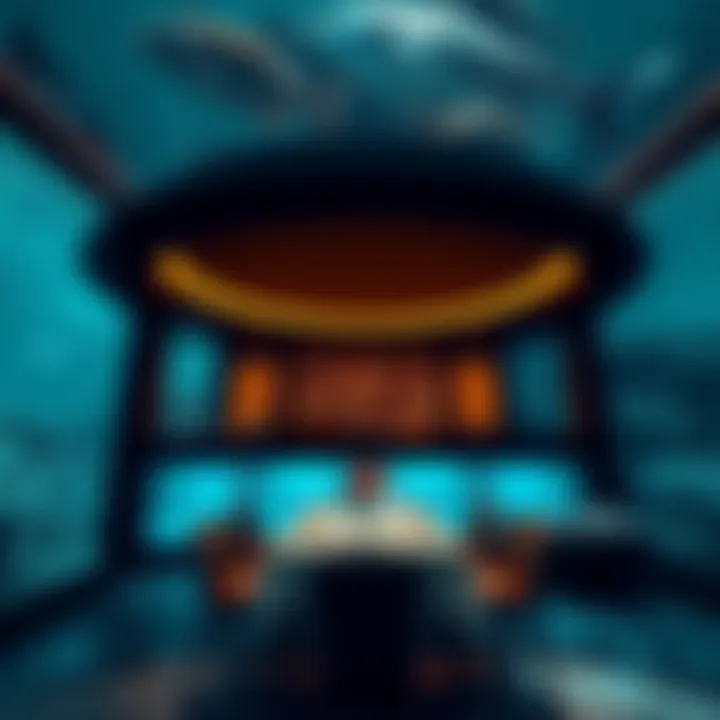Innovative Underwater Dining Experiences


Intro
Underwater dining experiences are not just a novelty; they encapsulate the essence of culinary innovation, meshing art, architecture, and gastronomy in ways previously unimaginable. As patrons find themselves sipping a merlot while school of fish glide by, the experience transcends mere sustenance. It introduces complexities around eco-friendly design, technological advancements, and amplified local tourism. The allure of dining beneath the waves poses a fascinating question: how do these establishments balance luxury with sustainability?
In this article, we will delve into various aspects of underwater restaurants, from architectural marvels that make them possible to their economic implications within contemporary gastronomy. Such discussions are particularly relevant to investors, buyers, agents, developers, and expatriates interested in tapping into this niche market with financial literacy and ethical considerations at play.
Market Insights
Current Trends
The popularity of underwater restaurants is anything but a passing fad. In places like Dubai and the Maldives, these establishments have become synonymous with luxury and adventure, harnessing cutting-edge technology while celebrating marine conservation. Trends show an uptick in clientele seeking unique experiences that intertwine exceptional meals with breathtaking views.
- Sustainability: With increasing awareness of ecological issues, many underwater venues incorporate local marine life conservation efforts into their business models. This has become a selling point that attracts conscientious diners.
- Technological Integration: Many underwater eateries are leveraging technology to enhance the dining experience, from augmented reality menus to smart glass that can become transparent at your whim, allowing one to experience the surrounding aquatic life in a different light.
Price Analysis
When considering entering this exotic market, financial dynamics play a critical role. The cost of setting up an underwater restaurant can vary vastly based on factors such as location, design, and operational expenses. On average, the initial investment can run into several million dollars, especially for structures built directly into coral reefs or protected marine areas.
An exhaustive price analysis reveals several key components:
- Initial Capital: Given the underwater setting, costs associated with construction and maintenance are significantly higher than a conventional restaurant.
- Operational Costs: These include the specialized staff required to manage underwater dining, maintenance of facilities, and compliance with marine-related regulations.
With a target audience keen on unique experiences, the average ticket price tends to be higher, often ranging from $200 to $500 per person in flagship locations.
Investment Strategies
Buying vs. Renting
Investors interested in launching a venture might ponder whether to buy or rent a location. Both paths come with their own sets of advantages and disadvantages:
- Buying: This provides long-term stability and control over the property, allowing for tailored modifications that align with sustainability goals. However, the upfront cost can be daunting.
- Renting: Offers flexibility, allowing investors to gauge the market before committing fully. Yet, they may encounter limitations in customizing the space.
Financing Options
Understanding various financing options is crucial for potential investors. Different avenues can be explored such as:
- SBA Loans: Government-backed loans providing favorable terms to small business owners.
- Private Equity: Partnering with local investors who share a vision can offset initial costs.
- Crowdfunding: Tapping into community interest and ensuring local support can not only assist in funding but also create buzz around the establishment.
In summary, underwater restaurants present a captivating blend of culinary creativity and economic opportunity. By navigating the waters of market insights and investment strategies, stakeholders can ensure a profitable and sustainable venture in this niche culinary market.
Understanding Underwater Restaurants
Underwater restaurants represent a remarkable fusion of gastronomy and marine exploration. They not only provide a unique dining experience but also provoke consideration of various aspects such as architectural beauty, ecological impact, and cultural significance. As culinary innovation keeps evolving, these dining venues dive deeper into uncharted flavors and concepts, inviting patrons to engage with both their palates and the mesmerizing underwater environment. Importantly, exploring this niche helps investors and developers, well, understand the dynamics of this unique market within tourism.
Definition and Concept
Simply put, an underwater restaurant is an establishment submerged in water, allowing diners to enjoy meals while surrounded by aquatic life. This concept goes beyond just eating; it’s about creating a multi-sensory experience that enchants patrons with views of vibrant marine life, coral reefs, or gently drifting fish. The dining room often features large, transparent panels that offer a panoramic view of the underwater landscape. Engaging with such a carefully curated environment can make the act of dining feel more like an adventure.
To fully appreciate these establishments, one must consider their conceptual framework. They typically aim to harmonize with their surroundings, utilizing natural light and materials that blend seamlessly into the underwater ecosystem. Guests are not merely spectators but participants in an evolving narrative between land and sea. The appeal lies in the quaint juxtaposition of an exquisite meal against the vibrant backdrop of ocean life – it’s a dining experience like no other.
Evolution of Dining Spaces


The journey of dining spaces has undergone a dramatic transformation over the centuries, shifting from basic outdoor settings to elaborate, immersive experiences that span both high-altitude and deep-sea establishments. Underwater restaurants have emerged from the breakthroughs in architectural design, engineering, and a growing desire to push culinary boundaries.
Initially, fine dining took place in opulent settings above sea level, but over time gastronomes sought out new frontiers. The historical context of dining incorporates everything from cave-like dinner venues to rooftop gardens. However, it’s the desire to create an experience that encapsulates both beauty and innovation that truly has fueled the spread of underwater venues.
This shift can be attributed to several factors:
- Technological Advancements: Modern engineering has enabled the construction of durable and safe underwater spaces.
- Societal Changes: As people seek novel experiences, the demand for unique dining options has grown.
- Environmental Awareness: A heightened appreciation for the ocean and its ecosystems has inspired the creation of establishments that celebrate marine life.
Through examining this evolutionary path, one can appreciate the growth of underwater restaurants and the profound impact they have on contemporary dining culture. These venues not only break conventional boundaries but also encourage thoughtful conversations about sustainability and the role of dining in a modern, interconnected world.
Architectural Innovations
Architectural innovations in underwater restaurants are not just matters of aesthetics but essential to ensuring that these unique dining establishments can operate effectively and sustainably in challenging marine environments. The interplay of artistry and engineering reflects both the advanced technologies employed and the intricate design principles that seek to harmonize human experience with the aquatic world.
Design Principles
The design of an underwater restaurant goes well beyond merely placing a structure beneath the waves. It must marry functionality with an unforgettable experience. This balance of form and utility often entails:
- Curvilinear Shapes: These organic forms mimic the natural contours found in underwater environments. They also help reduce water pressure impacts on the structure, allowing for larger windows that enhance the views of marine life.
- Visibility and Light: An emphasis on maximizing natural light penetration helps create an inviting atmosphere. Large panoramic panels can provide sightlines to mesmerizing aquatic life, drawing diners' eyes toward the vibrant underwater scenery.
- Integration with the Environment: Rather than disrupting marine ecosystems, contemporary designs often embrace their surroundings. Features like coral gardens or underwater landscaping can promote marine biodiversity while enhancing the dining experience.
"A well-designed underwater restaurant should feel like an extension of the ocean, inviting rather than intrusive, with every element working in concert with the natural flow of water and life."
Materials Used in Construction
Building beneath the surface of the water poses unique challenges, and thus, the materials specified must withstand both pressure and corrosion while promoting sustainability. Key materials include:
- Acrylic Panels: These lightweight yet sturdy materials are often favored for large viewing windows, providing both clarity and strength to withstand the forces of water pressure.
- Reinforced Concrete: Used in the structural framework, this material offers excellent durability and is resistant to marine growth.
- Anti-corrosion Coatings: Special Zinc-based coatings or paints keep the metal components of the restaurant-from fixtures to reinforcements-free from rust and decay.
- Natural Materials: Wood and stone can be employed in ways that embrace eco-friendliness, especially when sourced sustainably. Bamboo is increasingly favored for its rapid growth and environmental benefits.
Engineering Challenges
Designing and building underwater restaurants brings forth several engineering challenges that must be addressed:
- Water Pressure Management: As depth increases, so does water pressure, which can potentially lead to structural failures if not adequately accounted for in the design phase.
- Seismic Considerations: Given that many underwater restaurants are located in areas susceptible to earthquakes or tidal waves, engineers must plan for these natural events, ensuring resilience and stability.
- Access for Maintenance: The restaurant’s structure must be accessible for periodic maintenance and repairs, which can complicate design decisions. Creativity in planning is key to preventing service disruptions that could impact the dining experience.
- Environmental Impact Assessments: Engineers are required to conduct thorough evaluations of potential effects on local marine ecosystems to mitigate any negative consequences of their construction practices.
All in all, architectural innovations in underwater restaurants are pivotal, influencing not just the immediate dining experience, but also setting a precedent for future developments within this niche market. They intertwine art, sustainability, and cutting-edge engineering to create unique spaces that celebrate the synergy between humans and nature.
Ecological Considerations
When discussing underwater restaurants, the ecological aspect becomes crucial. These dining establishments do not operate in isolation; rather, they sit at the confluence of human experience and marine ecosystems. Understanding this relationship can help ensure restaurants are designed not only for culinary delight but also to minimize ecological footprints.
Impact on Marine Ecosystems
Dining beneath the waves offers a unique vantage point to witness marine life. However, this proximity raises significant questions regarding the potential impact on ecosystems.
- Habitat Disruption: One main concern is how construction and operations might displace marine fauna. Disturbance of bottom habitats can lead to long-term consequences, affecting breeding grounds for various fish species.
- Pollution Risk: With guests enjoying meals, waste management becomes paramount. If not handled properly, food waste, sewage, and cleaning chemicals could seep into the ocean, jeopardizing water quality and coral reefs that rely on balanced ecosystems.
"Dining should contribute to the experience, not detract from the beauty of the sea."
- Marine Tourism Interaction: Besides just diners, increased human activity can lead to a surge in regional tourism. While this can spark economic growth, it can also lead to overfishing and habitat degradation unless guided by stringent regulations.
Innovative strategies, such as underwater gardens or fish farms, can be incorporated to mitigate these effects. Enhancing biodiversity through sustainable practices ensures that these ecosystems thrive alongside culinary projects.


Sustainable Practices
Sustainability isn't merely a buzzword; in the context of underwater dining, it is essential for the future of both restaurants and marine life. Implementing resilient practices can marry the culinary arts with ecological responsibility.
- Materials Choice: Many establishments favor sustainable and local materials for construction. For example, using reclaimed wood, stone, or glass can reduce the environmental impact.
- Energy Efficiency: Utilizing renewable energy sources, such as solar panels or tidal energy systems, can reduce reliance on fossil fuels. Innovative designs can harness ambient light and currents to create energy-efficient environments.
- Local Sourcing: The menu can highlight local produce and seafood, which reduces carbon footprints tied tightly with transport. By prioritizing seasonal ingredients, restaurants can also adapt and change their offerings throughout the year, promoting biodiversity in dining.
- Education and Awareness: Educating patrons about marine environments and the importance of sustainable practices can turn dining experiences into platforms for advocacy. Special events focusing on ocean conservation can strengthen ties with customers.
Choosing to prioritize eco-friendly methods not only helps combat the adverse effects of underwater dining on marine ecosystems but also positions restaurants as leaders in environmental stewardship. Investors and developers who recognize these values can create more meaningful and respectful connections between dining and the seas.
Following these practices creates a cyclical benefit – safeguarding marine life while offering diners an unforgettable experience, resonating with conscientious consumers.
Culinary Experience
The culinary experience within underwater restaurants plays a pivotal role in its charm and allure. It’s not just about eating; it’s about immersing oneself in a unique ambiance that engages all the senses. The fish swimming by the window, the sound of water gently lapping against the glass, and the gentle hum of marine life create an environment like no other. This sensory feast serves as a backdrop for the culinary delights presented on the plate, elevating a meal into an extraordinary experience.
Menu Development
In developing a menu for an underwater restaurant, several factors must be thoughtfully considered. The key is to curate dishes that not only delight the palate but also resonate with the ambiance of the aquatic environment. Local ingredients should take center stage, showcasing the freshest catches from nearby waters. For instance, if the restaurant is located in the Maldives, dishes might highlight tuna, grouper, or lobster, celebrated for their quality and flavor.
Moreover, the presentation of dishes is essential. Just as marine life is vibrant and colorful, the food must match that visual dynamism. Each plate should be an artwork, with careful attention to color, texture, and arrangement. Seasonal menus can also attract repeat visitors, as they offer something new on each visit. Creativity is crucial; perhaps an unexpected twist on a classic dish could make it more appealing.
Local vs. Global Cuisine
Striking the right balance between local and global cuisine can be a real conundrum for underwater restaurants. On one hand, there’s a strong push to celebrate local cultures and ingredients. On the flip side, tapping into global culinary techniques and dishes can broaden the appeal to a diverse clientele.
Take, for example, a restaurant in the Caribbean. While offering traditional Caribbean flavors such as jerk seasoning and plantains, it could also introduce global elements like sushi rolls or Italian pasta, creatively infusing local seafood into these dishes. This fusion not only captures a wider audience but also encourages culinary exploration. Customers can experience local tastes while also enjoying familiar global flavors, making their dining adventure truly memorable.
Pairing Food with Environment
When it comes to pairing food with the environment in underwater restaurants, the options are as fluid as the waters themselves. The natural surroundings should inform not just the menu but also the way dishes are prepared and served. For instance, light and delicate flavors may suit a calm, turquoise sea setting, while heartier fare could complement a more dramatic, deep-blue backdrop.
Additionally, beverages should align with the culinary choices. For example, serving a crisp, refreshing white wine alongside a seafood dish enhances the dining experience, echoing the freshness of the marine environment. Furthermore, offering insights into the menu's inspiration can create a narrative that connects diners to their surroundings.
"To eat is a necessity, but to eat intelligently is an art."
Tourism and Economic Impact
Underwater restaurants have emerged as not just culinary innovations, but as significant contributors to the tourism sector and local economies. The marriage of unique dining experiences with breathtaking aquatic views attracts a diverse range of visitors keen on unusual gastronomic adventures. Additionally, these establishments have far-reaching economic implications that ripple through various sectors, underscoring the necessity to delve into the tourism and economic impact associated with such ventures.
Attraction of Tourists
The allure of dining inside a glass-enclosed space while surrounded by marine flora and fauna is simply irresistible. Pictures of diners next to schools of fish or observing the majesty of coral reefs can be found splashed across social media platforms, acting as digital souvenirs for those fortunate enough to partake in such experiences. As people increasingly crave unique experiences that provide both Instagram-worthy backdrops and memorable meals, underwater restaurants deliver in spades.
- Diversifying attractions: Many coastal destinations leverage underwater dining as a means to differentiate themselves from competitors. This sets up a unique selling point, turning passive beachgoers into curious diners eager to add an extraordinary element to their vacations.
- Key demographics: Families, honeymooners, and even corporate groups are a few of the categories drawn to these fascinating establishments. Travelers flock to destinations like Dubai for its avant-garde underwater venues, demonstrating that this niche can cater to various audiences and budgets.
- Sustainable tourism: With a growing interest in responsible travel, underwater dining experiences also lend themselves to promoting conservation efforts. Many of these venues prioritize sustainability, using eco-friendly materials and showcasing local seafood, enlightening diners about marine conservation in the process.
In short, the captivating nature of underwater dining elevates its status as an attraction, incentivizing tourists from all walks of life to explore these unique gastronomic havens.
Contribution to Local Economy
The economic implications of integrating underwater restaurants into a locale extend beyond mere tourism. They play a vital role in invigorating local economies by generating revenue and job creation. Underwater restaurants can be economic engines as they encourage spending not just within their walls but also stimulate surrounding businesses.
- Job Creation: From chefs skilled in preparing raw bar specialities to waitstaff trained in providing premium service, every aspect of an underwater restaurant necessitates a workforce. This often translates into numerous job opportunities for local residents.
- Local sourcing of materials: Many underwater establishments prioritize local seafood and produce to craft their menus. By fostering direct relationships with local fishermen and farmers, these businesses support the local economy while reducing their carbon footprint.
- Increased demand for related services: As visitors flock to experience glass-bottom dining, ancillary services—like hotels, transportation, and recreational activities—see a boom as well. The establishment of an underwater restaurant can lead to a virtuous cycle of economic activity in the region.


"The economic ripple effect of underwater dining reaches various sectors, displaying its capacity to boost employment and support local businesses."
Global Examples
Examining global examples of underwater restaurants reveals not only the creativity inherent in modern gastronomy but the transformative potential these establishments hold for tourism and the local economy. Each underwater restaurant represents a unique fusion of culinary artistry and architectural ingenuity, demonstrating how the dining experience can transcend traditional boundaries and engage patrons in truly immersive environments.
Iconic Underwater Restaurants
Numerous underwater restaurants have garnered international acclaim, setting benchmarks in design and experience. Notable examples include:
- Ithaa Undersea Restaurant (Maldives): Located five meters below sea level, Ithaa offers a 180-degree panoramic view of marine life. Opened in 2005, it features a contemporary European menu and is designed to blend seamlessly with the ocean surroundings. The visual spectacle of vibrant fishes swimming above complements the fine dining experience, making it a pervasive hit among tourists.
- Subsix (Maldives): This venue beneath Niyama Private Islands features submerged decor and an atmosphere that melds natural oceanic elements with modern aesthetics. Known for hosting unforgettable parties, it elegantly brings nightlife into the depths of the ocean.
- Underwater Restaurant at The London Resort (UK): Though still under development, this ambitious project promises to redefine underwater dining with a strong focus on sustainability. Designed to cater to a diverse range of diners, it aims to attract both locals and international visitors.
The significance of these iconic establishments lies in their ability to draw patrons, not just for the food but for the holistic experience of dining underwater. They showcase the pristine beauty of the ocean while raising awareness about marine conservation.
Case Study: Underwater Dining in Dubai
Dubai’s underwater dining scene is particularly fascinating, with the city’s bold ambitions to strengthen its status as a global hub for luxury and entertainment. A noteworthy example is Ossiano, situated within the Atlantis, The Palm resort. It is celebrated for its extravagant atmosphere and innovative menu that emphasizes seafood.
- Ambiance: Guests are surrounded by a massive aquarium that houses a wealth of marine species, enhancing the experience and creating a sense of wonder.
- Culinary Offerings: The menu is crafted to merge Middle Eastern flavors with world cuisine, utilizing fresh, locally-sourced ingredients whenever possible. Ossiano not only entices palates but also educates diners on the importance of sustainable fishing practices.
- Economic Impact: This underwater dining experience contributes significantly to Dubai's tourism, encouraging culinary tourism and promoting the local economy.
The future of underwater dining in Dubai appears promising. As the demand for unique experiences grows, further investments and innovations could bolster the city's reputation, making it a precedent-setting location in the global landscape of underwater restaurants.
"Underwater restaurants provide a unique intersection of cuisine and marine awareness, gifting guests not just a meal but an awareness of the ocean's wonders."
Through these examples, it becomes apparent that underwater restaurants are not merely novelties but pivotal players in the culinary tourism arena. They pave the way for discussions about sustainability, luxury, and the intersection of culture and cuisine.
For further exploration, you can check this relevant resource: Ocean Conservation.
Future Trends
The realm of underwater restaurants is not just a passing fancy; it’s a burgeoning sector that intertwines culinary delight with remarkable creativity and sustainability. As we look ahead, several key trends provide insight into how this unique dining experience will evolve, both in terms of technology and consumer expectations. By understanding these future trends, investors, developers, and culinary enthusiasts can better shape their strategies and offerings in this niche market.
Technological Advancements
In the fast-paced world we live in, technology plays a pivotal role in defining experiences, especially in venues that seek to captivate the senses underwater. Innovations such as immersive dining technologies enhance the atmosphere and make the surrounding marine life an integral part of the meal.
- Augmented Reality (AR): Through the use of AR glasses or devices, diners can interactively learn about the aquatic life surrounding them. This not only adds educational value but also elevates the dining experience to a level of engagement previously unseen.
- Drone Services: Imagine a scenario where drones deliver delicacies directly to your table, gliding gracefully through water with rare aquatic plants as decoration. This system can streamline service, offering a unique twist that consumers are likely to gravitate toward.
- Energy Efficient Designs: As sustainability becomes increasingly vital, many upcoming underwater establishments focus on energy-efficient designs. Utilizing solar power and renewable resources will reduce their carbon footprint, aligning with global efforts to mitigate climate change.
Technological advancement isn’t just about enhancing the culinary flavor; it’s about creating a holistic experience that aligns with modern sensibilities.
Evolving Consumer Preferences
The modern diner is a savvy individual who seeks more than just a meal; they want an experience that resonates on a deeper level. Evolving preferences show a shift toward sustainable practices, local sourcing of ingredients, and authenticity in culinary offerings.
- Sustainability Matters: Diners are increasingly concerned about environmental impact. Restaurants that can showcase their commitment to sustainable sourcing, such as sea vegetables and other local catches, will likely be favored from a marketing standpoint.
- Cultural Experiences: More than ever, food is intertwined with cultural narratives. Diners prefer not just to eat, but to understand the story behind their food. This need for authenticity leads underwater restaurants to incorporate local flavors and traditional cooking methods.
- Health Consciousness: With a growing interest in health and wellness, menus that cater to dietary restrictions and emphasize organic or ethically farmed produce will likely capture consumer interest.
As consumer preferences evolve, establishments that adapt to these trends while maintaining originality will find themselves at a distinct advantage.
Potential for Expansion
The potential for expansion in the underwater restaurant sector remains broad, reaching far beyond mere physical establishments. New locations can be opened in diverse marine environments, transforming remote areas into culinary destinations.
- Emerging Markets: Countries with pristine marine environments, such as those in Southeast Asia, have begun to see the emergence of underwater eateries. These places not only attract tourists but can also boost the local economy through job creation.
- Unique Experiences Beyond Dining: Some aspiring entrepreneurs are exploring options to incorporate underwater resorts, spas, and other leisure activities alongside dining experiences to appeal to a broader audience. This multifaceted approach can position a brand uniquely in a competitive market.
- Collaborations with Marine Conservation Groups: Working alongside environmental organizations, underwater restaurants can contribute to marine conservation while bolstering their sales. Establishing partnerships that promote awareness of aquatic ecosystems can increase brand visibility and trust.
"The future of underwater dining is not just about food; it's about redefining the interactions between humans and the ocean's wonders."
As we contemplate the expansion potential, it's crucial to remain vigilant and sensitive to ecological ramifications, striking a balance between culinary innovation and environmental responsibility.







